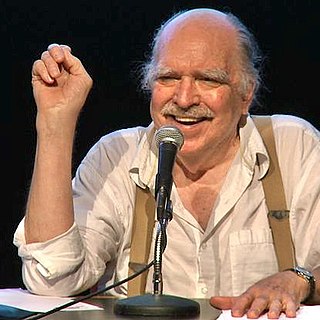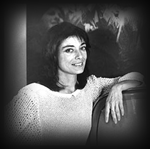Related Research Articles

Performance art is an artwork or art exhibition created through actions executed by the artist or other participants. It may be witnessed live or through documentation, spontaneously developed or written, and is traditionally presented to a public in a fine art context in an interdisciplinary mode. Also known as artistic action, it has been developed through the years as a genre of its own in which art is presented live. It had an important and fundamental role in 20th century avant-garde art.

The Holodeck is a fictional device from the television franchise Star Trek which uses "holograms" to create a realistic 3D simulation of a real or imaginary setting, in which participants can freely interact with the environment as well as objects and characters, and sometimes a predefined narrative.
Intermedia is an art theory term coined in the mid-1960s by Fluxus artist Dick Higgins to describe the strategies of interdisciplinarity that occur within artworks existing between artistic genres. It was also used by John Brockman to refer to works in expanded cinema that were associated with Jonas Mekas' Film-Makers’ Cinematheque. Gene Youngblood also described intermedia, beginning in his Intermedia column for the Los Angeles Free Press beginning in 1967 as a part of a global network of multiple media that was expanding consciousness. Youngblood gathered and expanded upon intermedia ideas from this series of columns in his 1970 book Expanded Cinema, with an introduction by Buckminster Fuller. Over the years, intermedia has been used almost interchangeably with multi-media and more recently with the categories of digital media, technoetics, electronic media and post-conceptualism.

James Tenney was an American composer and music theorist. He made significant early musical contributions to plunderphonics, sound synthesis, algorithmic composition, process music, spectral music, microtonal music, and tuning systems including extended just intonation. His theoretical writings variously concern musical form, texture, timbre, consonance and dissonance, and harmonic perception.
Computer art is any art in which computers play a role in production or display of the artwork. Such art can be an image, sound, animation, video, CD-ROM, DVD-ROM, video game, website, algorithm, performance or gallery installation. Many traditional disciplines are now integrating digital technologies and, as a result, the lines between traditional works of art and new media works created using computers has been blurred. For instance, an artist may combine traditional painting with algorithm art and other digital techniques. As a result, defining computer art by its end product can thus be difficult. Computer art is bound to change over time since changes in technology and software directly affect what is possible.

Carolee Schneemann was an American visual experimental artist, known for her multi-media works on the body, narrative, sexuality and gender. She received a B.A. in poetry and philosophy from Bard College and a Master of Fine Arts from the University of Illinois. Originally a painter in the Abstract Expressionist tradition, Schneeman was uninterested in the masculine heroism of New York painters of the time and turned to performance-based work, primarily characterized by research into visual traditions, taboos, and the body of the individual in relation to social bodies. Although renowned for her work in performance and other media, Schneemann began her career as a painter, stating, "I'm a painter. I'm still a painter and I will die a painter. Everything that I have developed has to do with extending visual principles off the canvas." Her works have been shown at the Los Angeles Museum of Contemporary Art, the Museum of Modern Art in New York, the London National Film Theatre, and many other venues.
The London Film-makers' Co-op, or LFMC, was a British film-making workshop founded in 1966. It ceased to exist in 1999 when it merged with London Video Arts to form LUX.
John Hales Whitney Sr. was an American animator, composer and inventor, widely considered to be one of the pioneers of computer animation.
Frank Popper was a Czech-born French-British historian of art and technology and Professor Emeritus of Aesthetics and the Science of Art at the University of Paris VIII. He was decorated with the medal of the Légion d'honneur by the French Government. He is author of the books Origins and Development of Kinetic Art, Art, Action, and Participation, Art of the Electronic Age and From Technological to Virtual Art.

USCO was an American media art collective in the 1960s, founded by Gerd Stern, Michael Callahan, Steve Durkee, Judi Stern, and Barbara Durkee in New York. The name USCO is an acronym for Us Company or the Company of Us. The collective was most active during the years 1964–66. USCO exhibited in the United States, Canada, and Europe, and is considered a key link in the development of expanded cinema, visual music, installation art, multimedia, intermedia, and the Internet. In addition, USCO's strobe environments heralded new media art.

Gene Youngblood was an American theorist of media arts and politics, and a respected scholar in the history and theory of alternative cinemas. His best-known book, Expanded Cinema, was the first to consider video as an art form and has been credited with helping to legitimate the fields of computer art and media arts. He is also known for his pioneering work in the media democracy movement, a subject on which he taught, wrote, and lectured, beginning in 1967.

Virtual art is a term for the virtualization of art, made with the technical media developed at the end of the 1980s. These include human-machine interfaces such as visualization casks, stereoscopic spectacles and screens, digital painting and sculpture, generators of three-dimensional sound, data gloves, data clothes, position sensors, tactile and power feed-back systems, etc. As virtual art covers such a wide array of mediums it is a catch-all term for specific focuses within it. Much contemporary art has become, in Frank Popper's terms, virtualized.
Thyrza Nichols Goodeve is a writer, interviewer, artist, and teacher active in the field of contemporary art and culture.

New media art includes artworks designed and produced by means of electronic media technologies, comprising virtual art, computer graphics, computer animation, digital art, interactive art, sound art, Internet art, video games, robotics, 3D printing, and cyborg art. The term defines itself by the thereby created artwork, which differentiates itself from that deriving from conventional visual arts. New Media art has origins in the worlds of science, art, and performance. Some common themes found in new media art include databases, political and social activism, Afrofuturism, feminism, and identity, a ubiquitous theme found throughout is the incorporation of new technology into the work. The emphasis on medium is a defining feature of much contemporary art and many art schools and major universities now offer majors in "New Genres" or "New Media" and a growing number of graduate programs have emerged internationally. New media art may involve degrees of interaction between artwork and observer or between the artist and the public, as is the case in performance art. Yet, as several theorists and curators have noted, such forms of interaction, social exchange, participation, and transformation do not distinguish new media art but rather serve as a common ground that has parallels in other strands of contemporary art practice. Such insights emphasize the forms of cultural practice that arise concurrently with emerging technological platforms, and question the focus on technological media per se. New Media art involves complex curation and preservation practices that make collecting, installing, and exhibiting the works harder than most other mediums. Many cultural centers and museums have been established to cater to the advanced needs of new media art.

Hans Dieter Breder was a German-American interdisciplinary artist. He lived and worked in Iowa.
Coleen Fitzgibbon is an American experimental film artist associated with Collaborative Projects, Inc.. She worked under the pseudonym Colen Fitzgibbon between the years 1973-1980. Fitzgibbon currently resides on Ludlow Street in New York City and in Montana.
Cybernetic art is contemporary art that builds upon the legacy of cybernetics, where feedback involved in the work takes precedence over traditional aesthetic and material concerns. The relationship between cybernetics and art can be summarised in three ways: cybernetics can be used to study art, to create works of art or may itself be regarded as an art form in its own right.

Sherrie Rabinowitz (1950–2013) was an American video artist and a pioneer in satellite-based telecommunications art. She worked exclusively with Kit Galloway under the moniker Mobile Image from 1977 onwards. She co-founded the Electronic Café International (ECI), a performance space and real café housed in the 18th Street Arts Center in Santa Monica, California, with Galloway. She died in 2013, from complications due to multiple sclerosis.
Intermedia Systems Corporation was an American media technology company, co-founded in Cambridge, Massachusetts in 1969 by Gerd Stern and Michael Callahan. Stern and Callahan had been members of the media art collective USCO in the 1960s when they had lived in Rockland County, New York. Intermedia Systems Corporation produced multimedia art internationally during the 1970s.

Experimental animation is a form of animation in which motion pictures have their own rhythm and movement where it has no narration or a specific structure in animated films. It is considered to be subjective and non-linear that deals with philosophic and spiritual concerns that the artists and film-makers convey.
References
- ↑ Manovich, Lev. 2002. "Ten Key Texts on Digital Art: 1970–2000". Leonardo. 35 (5): 567–569.